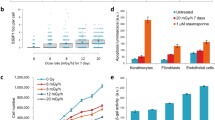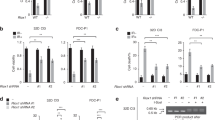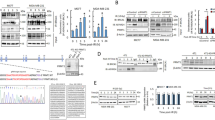Abstract
Irradiated cells induce chromosomal instability in unirradiated bystander cells in vitro. Although bystander effects are thought to be linked to radiation-induced secondary cancers, almost no studies have evaluated bystander effects in vivo. Furthermore, it has been proposed that epigenetic changes mediate bystander effects, but few studies have evaluated epigenetic factors in bystander tissues in vivo. Here, we describe studies in which mice were unilaterally exposed to X-irradiation and the levels of DNA damage, DNA methylation and protein expression were evaluated in irradiated and bystander cutaneous tissue. The data show that X-ray exposure to one side of the animal body induces DNA strand breaks and causes an increase in the levels of Rad51 in unexposed bystander tissue. In terms of epigenetic changes, unilateral radiation suppresses global methylation in directly irradiated tissue, but not in bystander tissue at given time-points studied. Intriguingly, however, we observed a significant reduction in the levels of the de novo DNA methyltransferases DNMT3a and 3b and a concurrent increase in the levels of the maintenance DNA methyltransferase DNMT1 in bystander tissues. Furthermore, the levels of two methyl-binding proteins known to be involved in transcriptional silencing, MeCP2 and MBD2, were also increased in bystander tissue. Together, these results show that irradiation induces DNA damage in bystander tissue more than a centimeter away from directly irradiated tissues, and suggests that epigenetic transcriptional regulation may be involved in the etiology of radiation-induced bystander effects.
This is a preview of subscription content, access via your institution
Access options
Subscribe to this journal
Receive 50 print issues and online access
$259.00 per year
only $5.18 per issue
Buy this article
- Purchase on Springer Link
- Instant access to full article PDF
Prices may be subject to local taxes which are calculated during checkout





Similar content being viewed by others
References
Balmain A, Harris CC . (2000). Carcinogenesis 21: 371–377.
Basnakian AG, James SJ . (1996). DNA Cell Biol 15: 255–262.
Baumann P, Benson FE, West SC . (1996). Cell 87: 757–766.
Baumann P, West SC . (1998). Trends Biochem Sci 23: 247–251.
Bowen NJ, Palmer MB, Wade PA . (2004). Cell Mol Life Sci 61: 2163–2167.
Ehrlich M . (2002). Oncogene 21: 5400–5413.
Esteller M, Herman JG . (2002). J Pathol 196: 1–7.
Feinberg AP, Tycko B . (2004). Nat Rev Cancer 4: 143–153.
Gaudet F, Hodgson JG, Eden A, Jackson-Grusby L, Dausman J, Gray JW et al. (2003). Science 300: 489–492.
Goldberg Z, Lehnert BE . (2002). Int J Oncol 21: 337–349.
Goldberg Z . (2003). Oncogene 22: 7011–7017.
Gonzalgo ML, Jones PA . (1997). Mutat Res 386: 107–118.
Haaf T, Golub EI, Reddy G, Radding CM, Ward DC . (1995). Proc Natl Acad Sci USA 92: 2298–2302.
Hall EJ . (2003). Health Phys 85: 31–35.
Helleday T . (2003). Mutat Res 532: 103–115.
Hendrich B, Tweedie S . (2003). Trends Genet 19: 269–277.
Hoeijmakers JH . (2001). Nature 411: 366–374.
Huang L, Snyder AR, Morgan WF . (2003). Oncogene 22: 5848–5854.
Huo L, Nagasawa H, Little JB . (2001). Radiat Res 156: 521–525.
Ichijima Y, Sakasai R, Okita N, Asahina K, Mizutani S, Teraoka H . (2005). Biochem Biophys Res Commun 336: 807–812.
Jaenisch R, Bird A . (2003). Nat Genet 33: 245–254.
Kalinich JF, Catravas GN, Snyder SL . (1989). Radiat Res 117: 185–197.
Kashino G, Prise KM, Schettino G, Folkard M, Vojnovic B, Michael BD et al. (2004). Mutat Res 556: 209–215.
Koturbash I, Pogribny I, Kovalchuk O . (2005). Biochem Biophys Res Commun 337: 526–533.
Kovalchuk O, Hendricks CA, Cassie S, Engelward AJ, Engelward BP . (2004). Mol Cancer Res 2: 567–573.
Little JB . (1999). CR Acad Sci III 322: 127–134.
Little JB . (1998). Int J Radiat Biol 74: 663–671.
Lundin C, Schultz N, Arnaudeau C, Mohindra A, Hansen LT, Helleday T . (2003). J Mol Biol 328: 521–535.
McGlynn P, Lloyd RG . (2002). Nat Rev Mol Cell Biol 3: 859–870.
Minamoto T, Mai M, Ronai Z . (1999). Carcinogenesis 20: 519–527.
Morgan WF . (2003a). Radiat Res 159: 567–580.
Morgan WF . (2003b). Radiat Res 159: 581–596.
Morgan WF, Hartmann A, Limoli CL, Nagar S, Ponnaiya B . (2002). Mutat Res 504: 91–100.
Mothersill C, Seymour CB . (2002). Radiat Res 158: 626–633.
Mothersill C, Seymour CB . (2004). Nat Rev Cancer 4: 158–164.
Mothersill CE, Moriarty MJ, Seymour CB . (2004). Int J Radiat Oncol Biol Phys 58: 575–579.
Mothersill C, Lyng F, Seymour C, Maguire P, Lorimore S, Wright E . (2005). Radiat Res 163: 391–399.
Maguire P, Mothersill C, Seymour C, Lyng FM . (2005). Radiat Res 163: 384–390.
Nagar S, Smith LE, Morgan WF . (2003). Cancer Res 63: 324–328.
Nagasawa H, Little JB . (1992). Cancer Res 52: 6394–6396.
Panayiotidis MI, Rancourt RC, Allen CB, Riddle SR, Schneider BK, Ahmad S et al. (2004). Antioxid Redox Signal 6: 129–136.
Pogribny I, Koturbash I, Tryndyak V, Hudson D, Stevenson SM, Sedelnikova O et al. (2005). Mol Cancer Res 3: 553–561.
Pogribny I, Raiche J, Slovack M, Kovalchuk O . (2004). Biochem Biophys Res Commun 320: 1253–1261.
Pogribny I, Yi P, James SJ . (1999). Biochem Biophys Res Commun 262: 624–628.
Ponnaiya B, Jenkins-Baker G, Bigelow A, Marino S, Geard CR . (2004). Mutat Res 568: 41–48.
Raiche J, Rodriguez-Juarez R, Pogribny I, Kovalchuk O . (2004). Biochem Biophys Res Commun 325: 39–47.
Richardson C, Stark JM, Ommundsen M, Jasin M . (2004). Oncogene 23: 546–553.
Robertson KD, Wolffe AP . (2000). Nat Rev Genet 1: 11–19.
Robertson KD . (2002). Oncogene 21: 5361–5379.
Robertson KD . (2001). Oncogene 20: 3139–3155.
Rogakou EP, Pilch DR, Orr AH, Ivanova VS, Bonner WM . (1998). J Biol Chem 273: 5858–5868.
Rothkamm K, Lobrich M . (2003). Proc Natl Acad Sci USA 100: 5057–5062.
Rothkamm K, Lobrich M . (2002). Int J Oncol 21: 433–440.
Rountree MR, Bachman KE, Herman JG, Baylin SB . (2001). Oncogene 20: 3156–3165.
Rugo RE, Almeida KH, Hendricks CA, Jonnalagadda VS, Engelward BP . (2005). Oncogene 24: 5016–5025.
Sawant SG, Randers-Pehrson G, Geard CR, Brenner DJ, Hall EJ . (2001). Radiat Res 155: 397–401.
Sigurdson AJ, Jones IM . (2003). Oncogene 22: 7018–7027.
Sokolov MV, Smilenov LB, Hall EJ, Panyutin IG, Bonner WM, Sedelnikova OA . (2005). Oncogene 24: 7257–7265.
Sonoda E, Sasaki MS, Buerstedde JM, Bezzubova O, Shinohara A, Ogawa H et al. (1998). EMBO J 17: 598–608.
Tawa R, Kimura Y, Komura J, Miyamura Y, Kurishita A, Sasaki MS et al. (1998). J Radiat Res 39: 271–278.
Turk PW, Laayoun A, Smith SS, Weitzman SA . (1995). Carcinogenesis 16: 1253–1255.
Wade PA . (2001). Oncogene 20: 3166–3173.
Ward JF . (2002). Mutat Res 499: 151–154.
West SC . (2003). Nat Rev Mol Cell Biol 4: 435–445.
X-5 Monte Carlo Team (2003). MCNP-A general Monte Carlo N-particle transport code, Version 5. LA-UR-03–1987; Los Alamos National Laboratory: Los Alamos, NM.
Xue LY, Butler NJ, Makrigiorgos GM, Adelstein SJ, Kassis AI . (2002). Proc Natl Acad Sci USA 99: 13765–13770.
Zhou H, Randers-Pehrson G, Waldren CA, Vannais D, Hall EJ, Hei TK . (2000). Proc Natl Acad Sci USA 97: 2099–2104.
Zhou H, Suzuki M, Geard CR, Hei TK . (2002). Mutat Res 499: 135–141.
Acknowledgements
We thank James Meservy and Igor Kovalchuk for their critical reading of this manuscript. We are grateful to Katrin Boelsterli, Sandie Stevenson, Mike Baker and Anh Bui for their technical assistance and to Karen Dow-Cazal for animal care. This work was supported by the CIHR and NSERC operating grants to Olga Kovalchuk. We also acknowledge Dennis Fitzpatrick (Vice-President (Research) and Christopher Nicol (Dean of Art's and Science) of the University of Lethbridge for financial support. Jonathan Loree was a recipient of the NSERC Undergraduate Summer Research Award. Research in the Engelward laboratory was supported by the US National Institutes of Health (R33CA84740; R01CA79827; P01-CA26731; NIEHS P30 ES001209–26A1; P30-ES02109) and by the US Department of Energy (DE-FG01-04ER04).
Author information
Authors and Affiliations
Corresponding author
Rights and permissions
About this article
Cite this article
Koturbash, I., Rugo, R., Hendricks, C. et al. Irradiation induces DNA damage and modulates epigenetic effectors in distant bystander tissue in vivo. Oncogene 25, 4267–4275 (2006). https://doi.org/10.1038/sj.onc.1209467
Received:
Revised:
Accepted:
Published:
Issue Date:
DOI: https://doi.org/10.1038/sj.onc.1209467
Keywords
This article is cited by
-
Environment factors, DNA methylation, and cancer
Environmental Geochemistry and Health (2023)
-
The emerging role of exosomes in radiotherapy
Cell Communication and Signaling (2022)
-
The role of connexin proteins and their channels in radiation-induced atherosclerosis
Cellular and Molecular Life Sciences (2021)
-
Detection of early changes in the muscle properties of the pectoralis major in breast cancer patients treated with radiotherapy using a handheld myotonometer
Supportive Care in Cancer (2021)
-
Adverse outcome pathways for ionizing radiation and breast cancer involve direct and indirect DNA damage, oxidative stress, inflammation, genomic instability, and interaction with hormonal regulation of the breast
Archives of Toxicology (2020)



